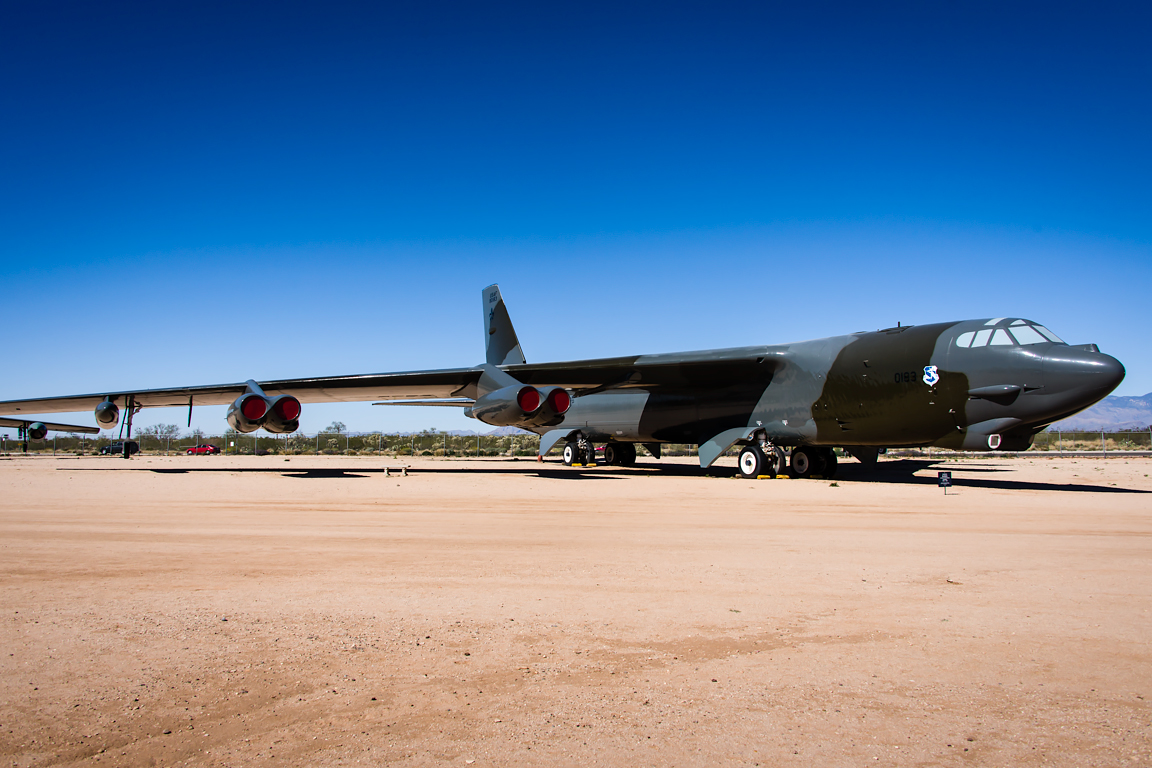Pima Air and Space Museum, Part 7
First up for today is the Fairey AEW MK.3 Gannet. It was designed for the Royal Navy (U.K.) to be used as a dedicated anti-submarine aircraft which could be launched from an aircraft carrier (its wings fold up as do most carrier-based aircraft).
To me, it is an odd-looking beast starting with the contra-rotating propellers. One propeller will spin clockwise, the outer counter-clockwise resulting in greater thrust from a given engine than a single-propeller design. It also provides more stable handling at low speed. The downside is that this design creates more noise.
The second odd-ball feature is that the plane looks pregnant. That is a radar dome enclosing a radar adapted from a predecessor aircraft. This adaptation then required a cascade of other modifications including moving the observer's cockpit, creating a new cabin, moving the exhaust, increasing the size of the vertical stabilizer and increasing the length of the undercarriage.
It began service in 1958 and was retired in 1978 — only 44 were built.

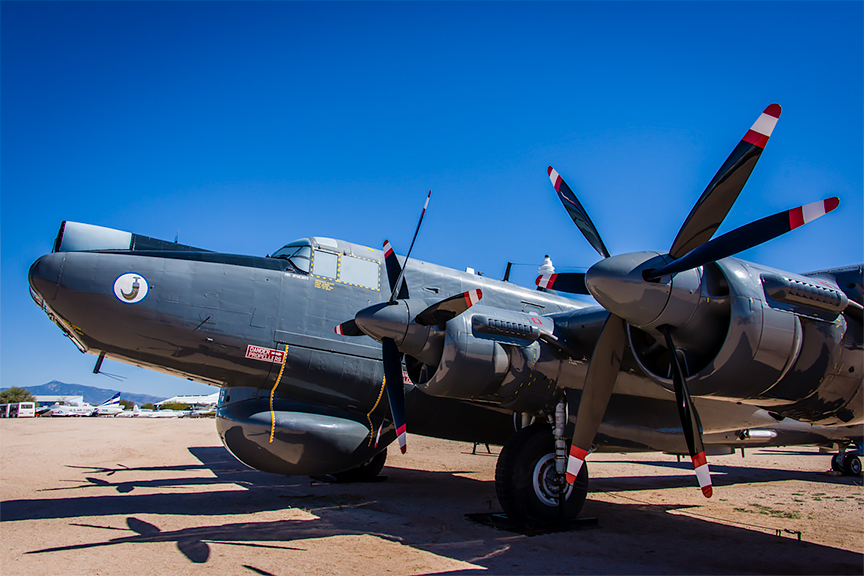 The next aircraft on display is another British design, the Avro AEW.2 Shackleton. Its role was long-range maritime patrol. The design was based on the Avro Lincoln bomber, itself being a development from the famous wartime Avro Lancaster bomber.
The next aircraft on display is another British design, the Avro AEW.2 Shackleton. Its role was long-range maritime patrol. The design was based on the Avro Lincoln bomber, itself being a development from the famous wartime Avro Lancaster bomber.
If you look closely, you'll notice that this aircraft also sports the contra-rotating propellers as seen on the aircraft in the previous photo.
It was introduced in 1951 and retired in 1991.
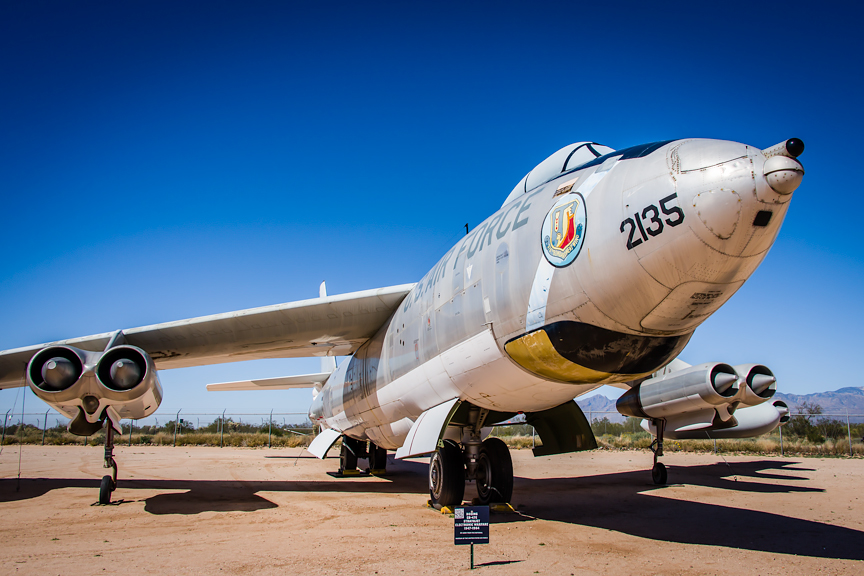 This is a landmark aircraft — the Boeing EB-47E Stratojet — the first all-jet bomber in the world. It was powered by six General Electric J47-GE-25A turbojets, producing 6,000 lb thrust each. The family of B-47s was designed to fly at high subsonic speed and at high altitude to avoid enemy interceptor aircraft. The primary mission was to drop nuclear bombs on the Soviet Union.
This is a landmark aircraft — the Boeing EB-47E Stratojet — the first all-jet bomber in the world. It was powered by six General Electric J47-GE-25A turbojets, producing 6,000 lb thrust each. The family of B-47s was designed to fly at high subsonic speed and at high altitude to avoid enemy interceptor aircraft. The primary mission was to drop nuclear bombs on the Soviet Union.
A number of B-47s were modified with a set of 16 jammers in a removable cradle stored in the bomb bay, plus radar warning receivers and chaff dispensers — these aircraft were renamed EB-47.
The original B-47 was introduced in 1951, some 2,032 of various models were built and the last one retired in 1977.
Note the unusual landing gear — two inline under the fuselage and two under the engines.
This next aircraft is the Convair B-36J Peacemaker, the largest bomber and the last piston engine-powered bomber produced by the United States. Because of concerns about the potential fall of Great Britain to Nazi Germany and the potential for Japanese strongholds in the Pacific, the U.S. Air Force issued an RFP for a long-range bomber that could strike Germany or Japan from North America. The result was the B-36.
The B-36 was the first bomber capable of delivering any of the nuclear weapons in the U.S. arsenal from inside its four bomb bays without aircraft modifications. With a range of 10,000 mi (16,000 km) and a maximum payload of 87,200 lb (39,600 kg), the B-36 was capable of intercontinental flight without refueling.
Beginning with the model designated B-36D, a pair of jet engines were added to the end of each wing. Consequently, the B-36 was configured to have ten engines, six radial propeller engines and four jet engines, leading to the B-36 slogan of "six turnin' and four burnin' ".
There were 384 built with the B-36 going into service in 1949 and being retired in 1959.
This aircraft is so large that I had to keep backing up in order to take a photo even though I was using the wide-angle end of the range in my zoom lens. I cropped this shot so it looks like a panoramic shot (actually only cut out some sky and dirt).
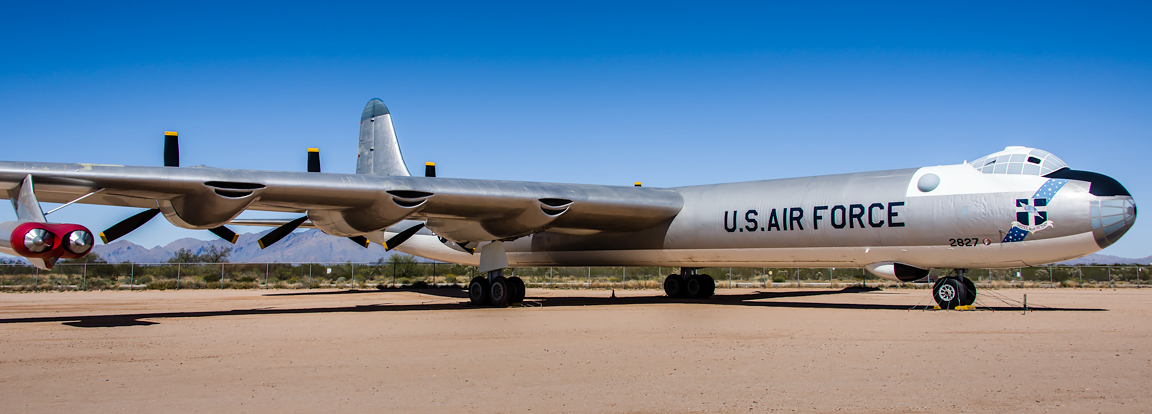
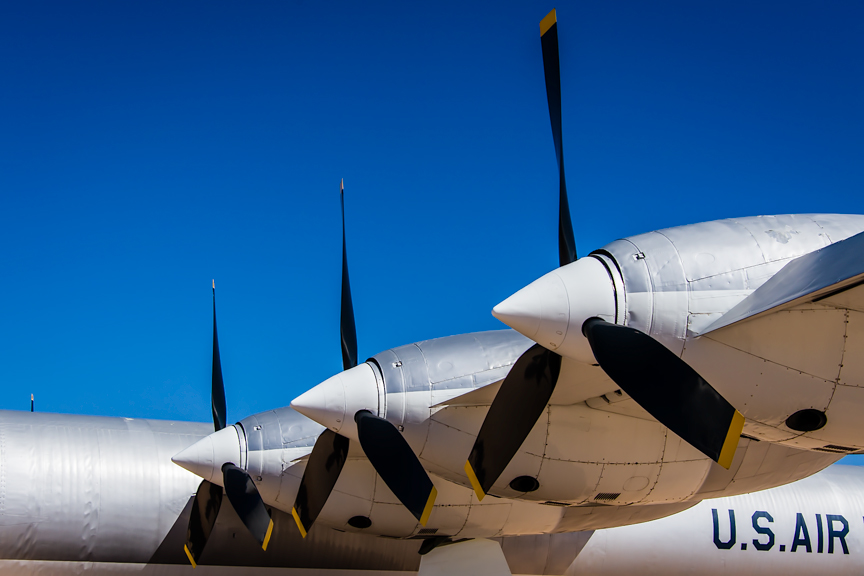 The propulsion system of the B-36 was unique, with six 28-cylinder Pratt & Whitney R-4360 'Wasp Major' radial engines mounted in an unusual pusher configuration, rather than the conventional four-engine, tractor propeller layout of other heavy bombers. The prototype R-4360s delivered a total of 18,000 hp (13,000 kW). While early B-36s required long takeoff runs, this situation was improved with later versions, delivering a significantly increased power output of 22,800 hp (17,000 kW) total.
The propulsion system of the B-36 was unique, with six 28-cylinder Pratt & Whitney R-4360 'Wasp Major' radial engines mounted in an unusual pusher configuration, rather than the conventional four-engine, tractor propeller layout of other heavy bombers. The prototype R-4360s delivered a total of 18,000 hp (13,000 kW). While early B-36s required long takeoff runs, this situation was improved with later versions, delivering a significantly increased power output of 22,800 hp (17,000 kW) total.
Each engine drove a three-bladed propeller, 19 feet (5.8 m) in diameter, mounted in the pusher configuration, thought to be the second-largest diameter propeller design ever used to power a piston-engined aircraft. This unusual configuration prevented propeller turbulence from interfering with airflow over the wing, but could also lead to engine overheating due to insufficient airflow around the engines, resulting in in-flight engine fires.
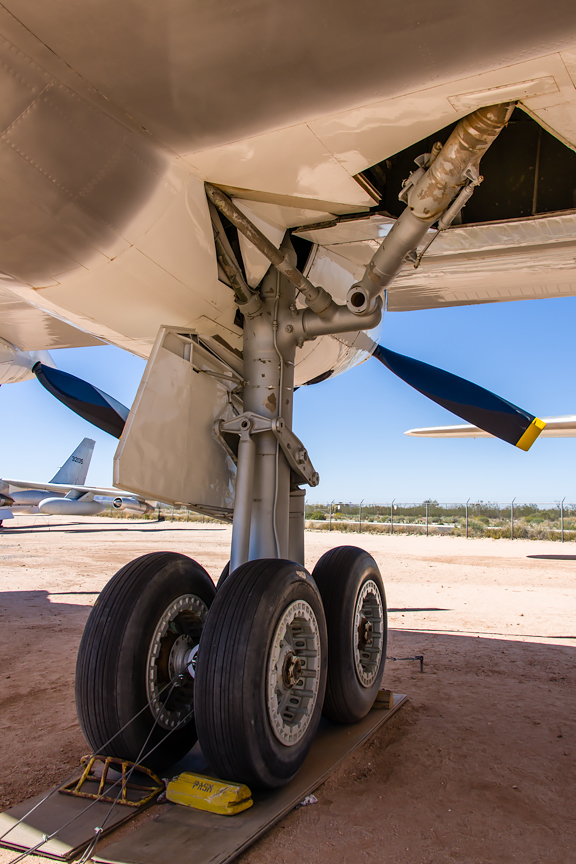 The XB-36 featured a single-wheel main landing gear whose tires were the largest ever manufactured up to that time, 9 feet 2 inches (2.79 m) tall, 3 feet (91 cm) wide, and weighing 1,320 pounds (600 kg), with enough rubber for 60 automobile tires. Because the loaded aircraft was too heavy for most runways, the single-wheel gear was soon replaced by a four-wheel bogie to spread the weight.
The XB-36 featured a single-wheel main landing gear whose tires were the largest ever manufactured up to that time, 9 feet 2 inches (2.79 m) tall, 3 feet (91 cm) wide, and weighing 1,320 pounds (600 kg), with enough rubber for 60 automobile tires. Because the loaded aircraft was too heavy for most runways, the single-wheel gear was soon replaced by a four-wheel bogie to spread the weight.
OMG, it's a B-52 — more precisely a Boeing B-52D Stratofortress. This was another of the model planes that I made as a kid so it also has a special place in my memories.
Beginning with the successful contract bid in June 1946, the B-52 design evolved from a straight wing aircraft powered by six turboprop engines to the final prototype YB-52 with eight turbojet engines and swept wings. The B-52 took its maiden flight in April 1952. Built to carry nuclear weapons for Cold War-era deterrence missions, the B-52 Stratofortress replaced the Convair B-36. A veteran of several wars, the B-52 has dropped only conventional munitions in combat. The B-52's official name Stratofortress is rarely used; informally, the aircraft has become commonly referred to as the BUFF (Big Ugly Fat F***er).

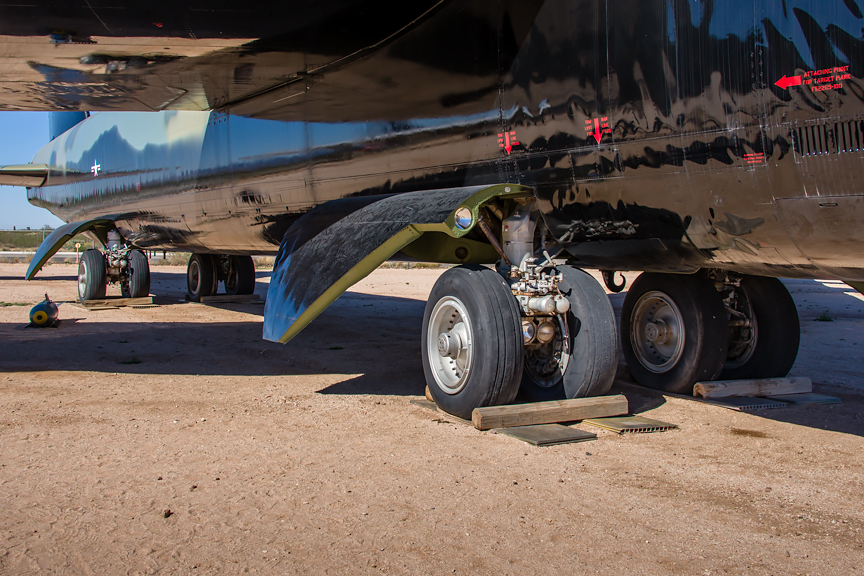 Again, the landing gear caught my interest — four two-wheel gear emerging from the fuselage. Doesn't look too stable to me but I guess it works.
Again, the landing gear caught my interest — four two-wheel gear emerging from the fuselage. Doesn't look too stable to me but I guess it works.
You might also notice the wavy pattern in the side of the fuselage. I was told that is metal fatigue — which I assume means this baby is not going to be flown again.
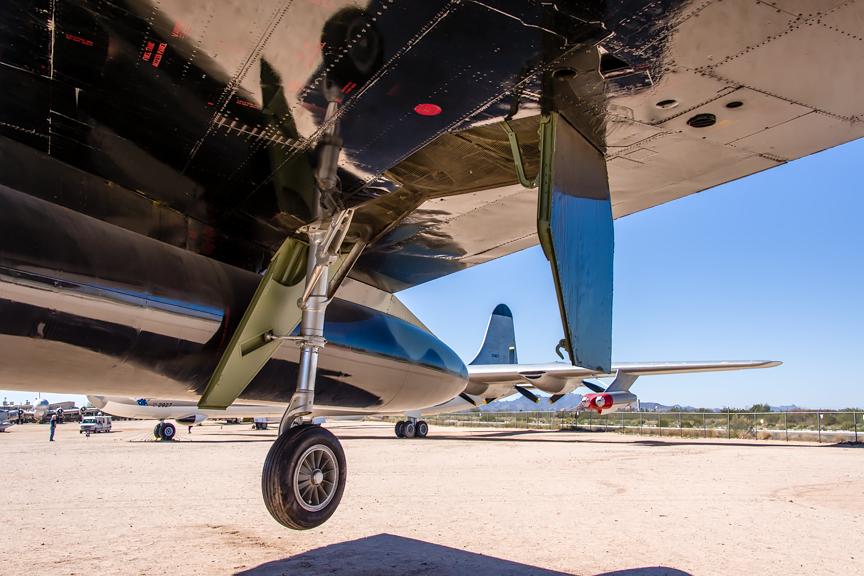 The B-52 features long swept-back wings. Here is an external fuel tank next to an extra landing gear (naturally, one of each on each wing). The purpose of the landing gear is to support the wing when the fuel tank is fully loaded or when the fuel is not balanced between the wing tanks.
The B-52 features long swept-back wings. Here is an external fuel tank next to an extra landing gear (naturally, one of each on each wing). The purpose of the landing gear is to support the wing when the fuel tank is fully loaded or when the fuel is not balanced between the wing tanks.
That brings me to a story I was told many years ago concerning the wings of a B-52. I was told that these wings flex quite a bit. Google tells me that they flex 18 feet up and 18 feet down. I'd say that's quite a bit.
I was also told that Boeing designed its 707 airliner based, in part, on the B-52. However Boeing was concerned that passengers would be uncomfortable seeing the wings flex as much as those on the B-52, so the wings were stiffened to only flex 10 feet in each direction.
Curiously, the greater flex in the wings reduces the turbulence that passengers feel when airborne. Thus, stiffening the wings has produced a less comfortable ride in commercial aircraft.
If this story is not true, I'm sure someone will set me straight.
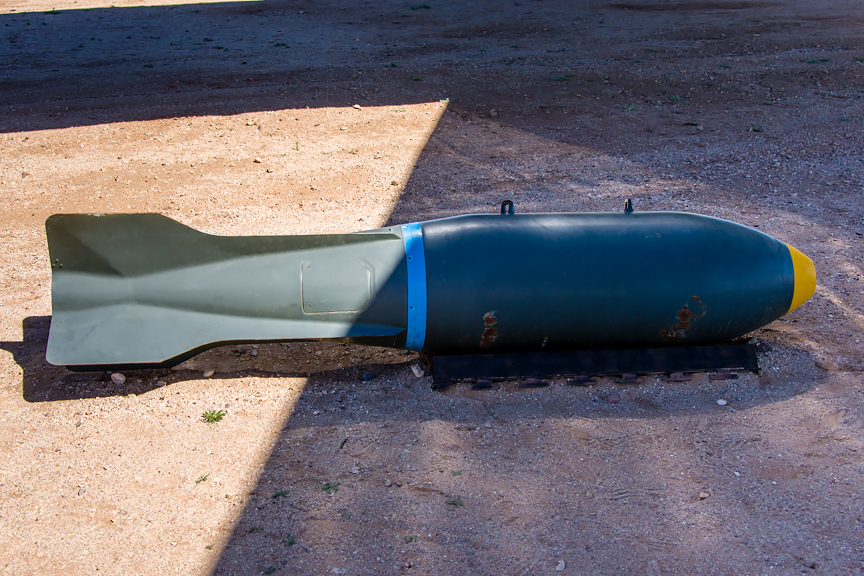 Where there are bombers, there must be bombs.
The M117 is an air-dropped general-purpose bomb used by United States military forces. It dates back to the time of the Korean War of the early 1950s. Although it has a nominal weight of 750 pounds (340 kg), its actual weight, depending on fuse and retardation options, is around 820 pounds (372 kg). Its explosive content is typically 403 pounds (183 kg) of Minol 2 or Tritonal. It can also be configured with a low-drag tail fin for medium and high-altitude deliveries.
Where there are bombers, there must be bombs.
The M117 is an air-dropped general-purpose bomb used by United States military forces. It dates back to the time of the Korean War of the early 1950s. Although it has a nominal weight of 750 pounds (340 kg), its actual weight, depending on fuse and retardation options, is around 820 pounds (372 kg). Its explosive content is typically 403 pounds (183 kg) of Minol 2 or Tritonal. It can also be configured with a low-drag tail fin for medium and high-altitude deliveries.
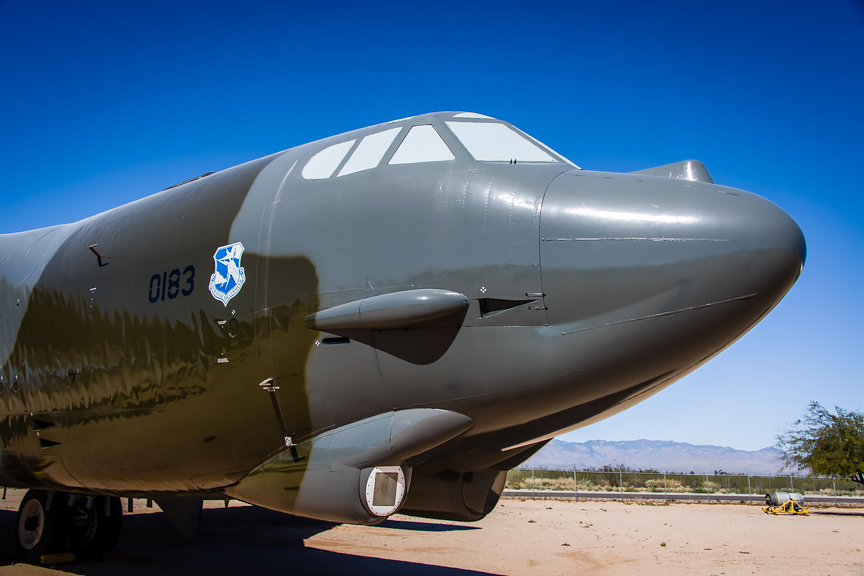 Wow! Here's another B-52, this one a slightly newer model Boeing B-52G Stratofortress. It was the first of the "short tail" versions of the aircraft with the tail a total of 8 feet shorter than the earlier versions.
Wow! Here's another B-52, this one a slightly newer model Boeing B-52G Stratofortress. It was the first of the "short tail" versions of the aircraft with the tail a total of 8 feet shorter than the earlier versions.
Other modifications significantly reduced the weight of the aircraft and moved the rear gunner from the tail of the plane to the main crew compartment where he operated his guns by remote control.
The "G" model participated in the B-52's second war in 1991 with 74 aircraft dropping a total of 36,590 bombs with a total weight of 11,742,000 pounds or 5,781 tons and participating in what were then the longest combat missions ever.
The B-52 entered service in 1955. They are still in service today. 744 were built.
The paint job on this aircraft is that of the 2nd Bomb Wing, 596th Bomb Squadron, Barksdale AFB, Louisiana. That is one handsome aircraft, especially with that paint job.
